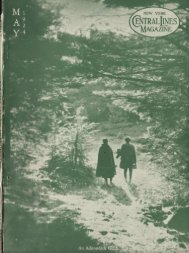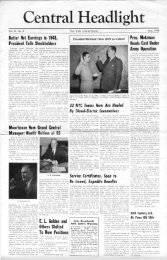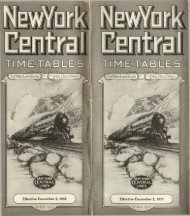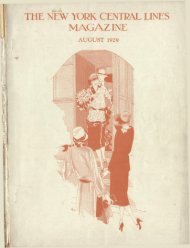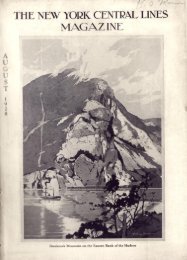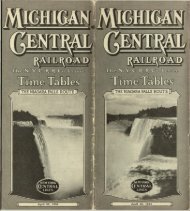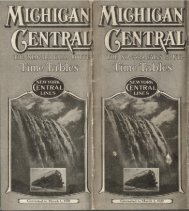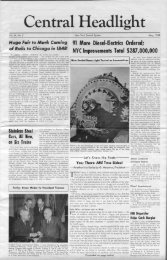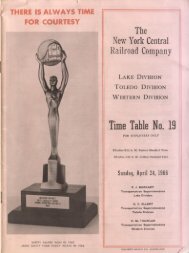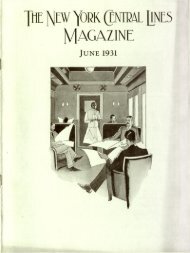Create successful ePaper yourself
Turn your PDF publications into a flip-book with our unique Google optimized e-Paper software.
48 New York Central Lines Magazine for May, 192S<br />
N the Pittsburgh & Lake Erie<br />
O Railroad, where F. H. Babcock is<br />
Safety Agent and L. A. Lee is Secretary<br />
of the General Safety Committee,<br />
noteworthy results have been obtained<br />
from the propaganda spread among<br />
employes by means of posters, contests,<br />
individual instruction and Safety<br />
meetings at which original papers<br />
have been read by the men themselves.<br />
Two papers presented during February<br />
stated the P. & L. E. Safety<br />
situation clearly, and were aimed at<br />
spurring the departments on toward<br />
completion of their design. A third,<br />
by C. W. Endean, Inspector at Pittsburgh,<br />
offered practical Safety advice<br />
in sentences whose initials spelled the<br />
phrase, "Thirty-five per cent less accidents<br />
by nineteen-thirty."<br />
M. J. Cagney, Supervisor of Track<br />
at McKeesport, Pa., spoke with pride<br />
of the past record of his road, but<br />
warned his fellow workmen that a<br />
battle half won may yet be lost<br />
through over-confidence.<br />
"Accomplishments in the saving of<br />
human life and limb have been many,"<br />
said Mr. Cagney, "and we congratulate<br />
ourselves on our splendid record<br />
for the past year over those of preceding<br />
years as we enter into the work<br />
of the present year with enthusiasm<br />
and confidence.<br />
"It is not only natural, but quite<br />
proper that we should do so. But let<br />
us not overlook the fact that many a<br />
battle half won has been lost through<br />
over-confidence. We cannot afford to<br />
overlook the danger of that tendency<br />
to ease up a bit which usually follows<br />
first success.<br />
"It has been said that the secret of<br />
success is to keep on succeeding. This<br />
cannot be done if we are too well satisfied<br />
with past achievements. The<br />
Safety work is only well begun and<br />
must be carried on with undiminished<br />
vigor and alertness. We must continue<br />
to preach vigorously, practise<br />
Safety and be alertly watchful for the<br />
thoughtless and careless worker, as<br />
only through teaching and training<br />
can we make ours a safe organization.<br />
"Teach our men the safe way to do<br />
their work and explain to them why<br />
it is not safe to do it otherwise. Train<br />
them to do it the safe way by insisting<br />
on strict observance of the rules<br />
until you have them in the habit of<br />
doing it safely. By so doing, we will<br />
perfect an organization !. hich will<br />
work Safely, not only from habit but<br />
also from knowledge of the danger of<br />
working any other way. The man<br />
who cannot be trained is not only a<br />
menace to himself but to all and must<br />
be eliminated from the organization.<br />
"These are the principles upon<br />
which our success to date is founded.<br />
Let us not lose sight of them or<br />
slacken our efforts, but push on with<br />
undaunted courage toward the goal of<br />
Safety always and for all."<br />
After pointing out that few accidents<br />
and no deaths were incurred<br />
through carelessness at the Dickerson<br />
Run Terminal during 1927, W. H.<br />
Simmons, General Foreman in the<br />
Rolling Stock Department there, adds:<br />
"My object in bringing this report<br />
before you is to emphasize more fully<br />
the difficult task which lies before this<br />
committee and the employes of this<br />
terminal in order to reduce our accidents<br />
during the year 1928. For the<br />
period from January 1, 1928, to February<br />
16, records in all departments<br />
here show but one lost-time accident,<br />
which is a good record to start out<br />
with, but in order to maintain this<br />
record it will require the united efforts<br />
of every employe in the service.<br />
We, as a Safety Committee, pledged<br />
ourselves to make this a banner year<br />
for Safety on the P. & L. E. Railroad,<br />
and to do this will necessitate each<br />
one's being constantly on the alert for<br />
unsafe practices and conditions and<br />
keeping the Safety movement before<br />
the employes at all times.<br />
"The P. & L. E. is in competition<br />
with other roads in the Safety movement<br />
for 1928, and our President, Mr.<br />
Crowley, has been very generous in<br />
offering a cup to the road producing<br />
the best record for the year. We have<br />
no use for accidents. They cause only<br />
misery and suffering. But we do have<br />
use for the cup, so why not pull together<br />
and push this Safety movement<br />
to the limit, and trade, to the mutual<br />
advantage of all, the things we do not<br />
want for the things we do want?<br />
"Let every employe be safe on the<br />
job, the cup be in our possession, and<br />
eventually we will have 35 per cent<br />
accident reduction by 1930!"<br />
Safety as it is Practised on One<br />
Section of the Big Four<br />
By W. P. Whitlow, Houston, Ohio<br />
E were called off our section a<br />
W<br />
while ago to help another gang<br />
in changing a few rails and I noticed<br />
that when we picked up the first one<br />
and started to walk away with it that<br />
there were men on both sides. Now<br />
if someone should have stumbled and<br />
caused the rail to fall to the ground,<br />
someone no doubt would have been<br />
hurt or probably crippled for life. It<br />
does not take any longer to do it the<br />
right way, so why take a chance?<br />
In tapping down spikes we stay two<br />
rails behind one another for fear a<br />
spike head may break and fly off.<br />
New York Central Lines Magazine for May, 1928 49<br />
In cutting bolts, nuts, rails or anything<br />
that may fly we use goggles to<br />
protect the eyes. These goggles are<br />
furnished us by the Company and we<br />
should always use them when the jobs<br />
we are on require them.<br />
We never use a tool that is in any<br />
way broken or unsafe, for by so doing<br />
we know we are not only liable to injure<br />
or hurt ourselves, but are breaking<br />
and trespassing upon the Safety<br />
rules of the Company.<br />
When a train is approaching we get<br />
clear of both tracks, for we never<br />
know when a chunk of coal or some<br />
other loose article may fall and hurt<br />
or injure someone.<br />
We watch for hot boxes, brakes that<br />
might be stuck, or any loose piece of<br />
material that might be dragging beneath<br />
the cars, for should we find any<br />
of these causes we can easily give the<br />
trainmen a signal and possibly save<br />
them from having a wreck.<br />
While going or coming from our<br />
work, in passing a switch someone<br />
will say, "The banners are white," to<br />
which our foreman will answer back,<br />
and by doing this we never pass a<br />
switch without seeing that it is safe.<br />
Public Go-operation Needed in<br />
Safety Movement<br />
By W. H. Fortney, Fireman, Big Four<br />
N my fifteen years of employment<br />
I<br />
with the Big Four Railroad, Safety<br />
First has been my paramount thought.<br />
Many times in my work it has come<br />
to me how accidents could be eliminated<br />
if the public would only heed<br />
and co-operate.<br />
Even our employes do not practise<br />
Safety as they should. Time after<br />
time I have warned men about kicking<br />
the drawbar with their feet. A short<br />
time ago I witnessed a man doing<br />
this very thing; he consequently lost<br />
his foot. Had he practised Safety<br />
First he would not have been injured.<br />
I believe there is not a railroad<br />
crossing in the country that does not<br />
have some Safety First sign on it, yet<br />
a woman was killed by train No. 6 recently<br />
while I was on duty firing. She<br />
had been warned by the flagman on<br />
No. 45 that a train was approaching<br />
on the eastbound track. Nevertheless<br />
she stepped into the path of our train<br />
and was killed instantly. This is just<br />
another instance where the applying<br />
of the simple rules of Safety on her<br />
part would have proved beneficial.<br />
In the years I have fired for the<br />
Big Four my aim has been to be on<br />
the seat box at places where it is most<br />
dangerous, namely, passing through<br />
small towns with street crossings and<br />
over public highways. This enables<br />
me to warn the engineer about anything<br />
that looks unsafe.<br />
People in this day and age do not<br />
realize the danger that lurks at every<br />
railroad crossing: not only to themselves,<br />
but to the engineman and fireman<br />
as well. The least the public can<br />
do to lighten their burden of responsibility<br />
is to use caution and judgment<br />
at all crossings.<br />
The public needs to be impressed<br />
with the vital importance of Safety<br />
First, and when this is accomplished,<br />
every man, woman and child will<br />
think and act Safety involuntarily.<br />
A d v e n t u r i n g into Safety o n the M i c h i g a n<br />
C e n t r a l<br />
By C. J. Burrough, Train Master, Michigan Central<br />
N the United States during the year<br />
I 1920 more than six per cent of all<br />
the deaths were violent deaths. In<br />
other words, out of every one hundred<br />
persons who died, six lost their lives<br />
because someone was careless.<br />
It has been said that "accidents will<br />
happen." However, education is the<br />
first step toward eliminating accidents—the<br />
realization of the importance<br />
of Safety.<br />
As we look over the year just passed<br />
we can see many things that were<br />
accomplished, which will make 1928,<br />
if improvements continue, the banner<br />
year.<br />
"Safety that lasts" is more important<br />
than "Safety First." Most mistakes<br />
are excusable only in so far as<br />
they are not carelessly repeated.<br />
The fact is, of course, that Safety<br />
is not the prime object in life. The<br />
most important object in the world is<br />
adventure, and by adventure I mean<br />
a fresh, first-hand experience of life.<br />
Safety then is leagued together in the<br />
noble company of recreation, love,<br />
friendship, loyalty, knowledge, art,<br />
creed and all the other main forces<br />
of life.<br />
A human life is the gift of Almighty<br />
God, and as such should be treasured<br />
and preserved. It is upon this bedrock<br />
that the Safety movement has<br />
built its admirable, effective structure.<br />
The whole world has responded<br />
to the inspiration and is moving forward<br />
with hope and confidence.<br />
What do you choose to have thrown<br />
out of your life and what do you<br />
choose to have put in its place? As<br />
for me, I choose adventure. I choose<br />
to have the bad adventure thrown out<br />
and the good adventure brought in,<br />
because I believe that adventure is in<br />
truth the deep, significant value in<br />
life, and by that token I believe that<br />
we have the real meaning of Safety.<br />
One year has gone, another one is<br />
here. Great work was done in 1927<br />
under the guidance of our Safety<br />
agents and committees. Our committee<br />
has gained strength in meeting<br />
with emergencies during the past year<br />
"Dis-obey that impulse!" is the title<br />
of the above poster printed in the<br />
Albany Buick News, which offers the<br />
suggestion that a good Safety stunt<br />
is to slow down and shift into second<br />
gear before crossing a railroad track.<br />
and, at times, we are subject to a<br />
test to prove our fitness. The Michigan<br />
Central Railroad has, and will<br />
always have, problems arise, and it is<br />
good for you and me to speak frankly<br />
of the great problems to be solved<br />
during 1928.<br />
The Safety agents and committees<br />
must be supported by the active backing<br />
of all railroad men who are capable<br />
of contributing to the cause.<br />
Our fields of endeavor touch upon<br />
so many phases of activity, there is<br />
work for all. A greater activity of a<br />
larger number is needed to sustain<br />
and maintain the purpose which the<br />
Safety agents and committees are trying<br />
to accomplish.<br />
We cannot all be on the committee,<br />
but we can all fill such effort with<br />
meaning by our support. The great<br />
work is yet to be done. More heads<br />
are needed.<br />
What a Mile of <strong>Railway</strong> Does<br />
in a Day<br />
//npHE average mile of railway line<br />
in the United States last year<br />
handled seven passenger trains and<br />
seven freight trains each day," says<br />
the <strong>Railway</strong> Age, in a discussion of<br />
the service performed by the steam<br />
railroads of the United States.<br />
"In dealing with railway traffic figures<br />
running into hundreds of millions<br />
and billions," continues the <strong>Railway</strong><br />
Age, "it is sometimes difficult to visualize<br />
the amount of work which is performed,<br />
on the average, by the units<br />
of the railway plant. The following<br />
figures, therefore, have been prepared<br />
on the average daily operations of<br />
each mile of railway line.<br />
"In the seven freight trains which<br />
passed each day over this average<br />
mile of railway there were 325 freight<br />
cars, of which 205 were loaded and<br />
120 empty. In the loaded cars was<br />
freight weighing, roughly, 5,600 tons,<br />
while the total weifcnt passing over<br />
this mile of line, including freight,<br />
locomotives and freight cars, was<br />
14,400 tons. The seven daily passenger<br />
trains which ran over this average<br />
mile included 46 passenger train<br />
cars and carried a total of 416 passengers.<br />
"The daily gross revenues earned by<br />
this average mile of railway line<br />
amounted to $72. The average direct<br />
operating expenses consumed 74 per<br />
cent of these total earnings, or $53<br />
daily. Next, a total of $4 a day was<br />
paid by this average mile to local,<br />
state and national tax collectors. After<br />
the payment of certain other expenses,<br />
including rental charges for<br />
property belonging to others, the average<br />
daily net earnings of this typical<br />
mile of railway line amounted to $13.<br />
This daily average net earning figure<br />
of $13 amounted in a year to a return<br />
of approximately 4% per cent on the<br />
average railway property investment<br />
per mile.





